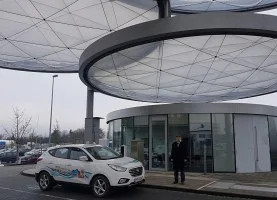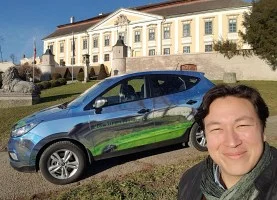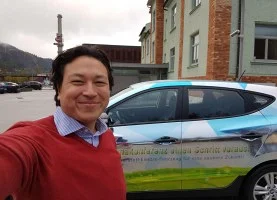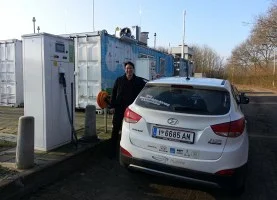Social Media
HYDROGEN REFUELLING STATIONS 7.2.2017

On 3 February 2017, Mortimer Schulz, the founder and owner of solutions in energy e.U., drove from Innsbruck to Munich to increase learning experience about HRS on the occasion of three stations with Linde technology in Munich Detmoldstrasse, Carl-von-Linde Strasse and Innsbruck Andechsstrasse.
Innsbruck
The journey began in Innsbruck at 08:20 in the morning in a Hyundai ix35 FCEV. At freezing temperature, the A12 Inntal-Autobahn was taken, continuing on North from Schwaz, TYROL via Achensee, across the Austro-German border to Tegernsee, BAVARIA following national routes B308/ B312 and arriving at Munich Detmoldstrasse HRS (TOTAL), near the BMW testing facility at 10:40.
Detmoldstrasse
Two gentleman of Linde AG kindly presented the hydrogen storage of a suburban 10,000 litre liquid hydrogen storage tank, with external hydrogen production and delivered there by a liquid hydrogen storage truck on regular basis. The hydrogen is kept at minus 253° degree Celsius, and can be either pumped cryogenically to deliver minus 220° degree Celsius at 350 bar, or "heated" to minus 30° to minus 40°-degree Celsius which I use to refuel the hydrogen into the FCEV at 700 bar.
Linde Hydrogen Center
Further, actual gaseous hydrogen refuelling of 390 bar, thus leading to 740 bar, took place at 12:15.
For the last 10 years, the Linde Hydrogen Center has been supplying liquid hydrogen LH2 and gaseous hydrogen GH2 at this state-of-the-art Hydrogen Refuelling Station, Test Centre and Exhibition Venue in a 3-in-1 concept with futuristic architecture. Since January 2017 it is open to the public and I refuelled with a CEP-card. The Centre is located next to the Gases Division of Linde AG.
Return trip from Munich to Innsbruck
Via A8 and A93, at 17:30 Innsbruck Andechsstrasse (OMV) was reached and 200 bars GH2 were refuelled to yield 740 bar, giving a range of 542 km. 436 km total were driven; at minus temperatures.
The social media channel www.facebook.com/solutionsinenergy/ refers. Please look up for details.
FCEV driving experience
Driving the Hyundai ix35 FCEV for meanwhile more than 7,000 kilometres, one of the open issues was still the Eco (E)-drive mode vs. the Drive (D)-drive mode. With “E” the acceleration is less than with “D”, and therefore the hydrogen consumption is slightly less (under 1 kilogram hydrogen per 100 kilometres), while with “D” slightly more than 1 kg H2/100km. In the mountains of Tyrol and Bavaria, on national routes, driving in “D” for a short while to climb up quickly was probably more efficient, and then switching to “E” on even roads for cruising (as previously pointed out by a gentleman from Hyundai Norway during the Hydrogen Challenge #2.0 Bergen-to-Bolzano 2,316 km in June 2016).
Press Statement Hydrogen Challenge #2.7 Hydrogen Refuelling Stations (PDF)
SIX SENSES TOUR IN GOBELSBURG 13.12.2016

On 13 December 2016, Mortimer Schulz, the founder and owner of solutions in energy e.U., drove from Vienna to Gobelsburg and tasted a young Grüner Veltliner, 2015, Ried Steinsetz, 13.0% vol. alc. The Vineyard and Castle were reached by driving the FCEV (average 1.5 kilograms of hydrogen per 100 kilometres). The wine-tasting and the FCEV were compared; thereby alluding to the six senses.
A) Sight Veltliner: light citric yellow going into pale but clear / FCEV: intense
B) Hearing Veltliner: you hear the cling of the glasses when you toast / FCEV: clean (something like “wwwwhhhh”)
C) Smell Veltliner: fruity but subtle; thanks to the Sun and cold winds from the North / FCEV: discreet and refreshing
D) Taste Veltliner: young but strong body with fruity and flowery elements / FCEV: balanced (see “FCEV senses” below)
E) Touch Veltliner: liquid pure / FCEV: brisk
F) Hydrogen Veltliner: elementary (in combination with carbon and oxygen) / FCEV: oxidised.
Also see: www.gobelsburg.at/weine, www.facebook.com/solutionsinenergy
FCEV senses
Emphasis was laid on experiencing the FCEV with all of the senses. The residual by-product “H2O” as was collected in a glass (see middle picture) was not yet tasted this time. Further testing coming up.
Schloss Gobelsburg
Thank you Eva Moosbrugger and Katharina Breitenecker for the tasting and delivering a superb wine. Family Moosbrugger operates the vineyard since 1996 and they are a member of the Österreichische Traditionsweingüter.
Press Statement Hydrogen Challenge #2.6 Six Senses Tour in Gobelsburg (PDF)
FCEV WINTER-TEST IN SLOVENIA 07.11.2016

On 7 November 2016, Mortimer Schulz, the founder and owner of solutions in energy e.U., undertook a journey in an FCEV provided by Hyundai Import, Inzersdorf. The trip began at 06:38 in Vienna driving 14 km to the first refuelling stop at Shuttleworth Str. OMV. 690 bars of hydrogen were refuelled and a range of 507 km was provided at 4° Celsius. After 402 km Lesce (SI) was reached at 12:59 with 111 km remaining range. Mr. Tadej Auer from the Development Centre for Hydrogen Technologies (DCHT), Ljubljana received me at Lesce, Triglav national park. We drove 19 kilometres to Jesenice to refuel at one of DCHT’s founding partners TPJ, Slovenia’s main gas utility company. Refuelling was done from a trailer with hydrogen storage tanks at 200 bar. At 2° C, the new range given was 170 km. The journey continued to Graz from 14:47 until 19:11 (incl. unexpected waiting at Karawankentunnel), with a distance of 190 km; 20 km more than the initial range. It was only made possible due to an average speed of 60-70 km/h. Given snow and fog other vehicles were not driving much faster. Refuelling in Graz was done by the Hycenta Research Centre facility on the TU Graz premises and 360 bars H2 were refuelled at 1° Celsius, giving a new range of 289 km. The last lag to Shuttleworth Str. OMV was completed at 21:40 after 205 km. Refuelling at 4° C resulted in 600 bars of hydrogen and a final range of 434 km shown. The final 15 km were driven to reach home at 22:25.
FCEV Winter Test
Emphasis during this Winter test trip was laid on the driving behaviour at Winter conditions. From the experience of previous trips, such as Innsbruck-Amsterdam and Bergen-Bolzano, it could be deduced that the cold temperatures did have an effect on the range, but not on the handling of the FCEV. The vehicle performed at all times with rapid response, easy-to-drive and recouping energy for the battery when decelerating to the advantage of extra mileage even in Winter weather conditions.
“E” ECO and “D” DRIVE-modes
The ECO-mode was chosen on the mountain roads and the DRIVE-mode on the highways. The ECO-mode is useful when the gas pedal is not pushed excessively. Driving at higher speeds means the fuel cell has to produce more power for the electric engine, and the range reduces progressively.
Slovenia’s First Hydrogen Filling Station
According to Mr. Tadej Auer, DCHT, the station in Lesce is due to be formally opened in early 2017.
Press Statement Hydrogen Challenge #2.4 Winter Test in Slovenia (PDF)
HYDROGEN CHALLENGE #2 BERGEN-BOLZANO 12./16.06.2016
This is a report from Mortimer Schulz, the owner and founder of solutions in energy e.U., who drove several different Hyundai Tucson ix35 FCEV (fuel cell electric vehicle) from Bergen, Norway, via Denmark, Germany and Austria to Bolzano, Italy (12/16 June 2016) with a total distance of 2,316 kilometres (km). I had the pleasure to join a group of hydrogen pioneers, organised by Hyundai Europe, to gain further experience in pursuing an extended journey in a fuel cell vehicle across Europe over a period of five days. At first 9 FCEVs started in Norway, and along the way more FCEVs joined, ending up with 15 FCEVs in Italy. Furthermore, 2 internal combustion engine (ICE) vehicles were joining the FCEV group to support the logistical effort. The hydrogen refuelling stops were Porsgrunn (N), Århus (DK), Hamburg (D), Duesseldorf (D), Geiselwind (D), Munich (D), Innsbruck (A) and Bolzano (I). This report focusses on the management of the hydrogen tour as a whole and sheds some light on the availability of hydrogen along the way, meaning not only to reach the final destination as planned, but also to make sure that all participating FCEVs arrive at the final destination as planned.

Day 1 – Folgefonna Nasjonalpark, Norway (national route 551)
Beginning in Norway, where 6 FCEVs from Hyundai Norway and 3 FCEVs from Hyundai Germany were already set up for the participants, the departure time at Bergen was 06:15 am. Driving at 80 kilometres per hour (km/h) along spectacular scenery, waterfalls and snowscapes, and listening to the P4 Norge radio station, the first hydrogen refuelling stop was reached at Porsgrunn, being one of five hydrogen refuelling stations operated by HYOP in Norway. According to the CEO of HYOP, it was built in 2007 already and it receives the hydrogen from a nearby industrial plant through a pipeline. At the station the hydrogen is then compressed to 700 bar to be pumped into the FCEVs. For the first refuelling 4.89 kilogram (kg) of hydrogen (H2) were filled after 426 kilometres (km) were driven since Bergen. The journey continued to the ferry port Larvik, to cross the North Sea to reach Denmark, and until arriving in Aalborg a total of 526 km were driven on Day 1.

Day 1 – Refuelling at HYOP, Porsgrunn
Day 2 began with a refuelling stop at Århus (4.04 kg H2 were filled) at a station run by H2Logic, which is a Norwegian-Danish company that has so far built 8 hydrogen refuelling stations in Denmark. The next stop was at Kolding where the FCEV group listened to a presentation by Hyundai Denmark and the Danish hydrogen association. Among others it was reiterated that Denmark has 9 refuelling stations so far with two more H2 stations to open in 2016, of which one just being inaugurated in June in Esbjerg, amounting to a total of 11 stations for a population of 5.6 million. Thereafter, continuing South across the Danish-German border to Hamburg, a second refuelling took place (4.61 kg H2) at the Vattenfall Hafencity station to prepare for a full tank for the next day. The city of Hamburg is blessed with 3 operational stations and two more under construction, as the whole of Germany is planning to add several more stations in the near future. A total of 453 km were driven on Day 2. Both Denmark and the North of Germany, Schleswig-Holstein, featured rather flat topography and a lively mixture of rain and sun. A support team, also organised by Hyundai Europe, driving in two combustion engine vehicles on each of the five days started ahead of the FCEVs to take care of the logistics at the next destination en route and to welcome the FCEVs upon arrival at each waypoint.

Day 2 – Refuelling at Århus (H2Logic)

Day 2 – Refuelling at Hamburg (Hafencity)
Day 3 was a pure German Autobahn day with two highlights. First, a presentation by Air Liquide was given at the hydrogen refuelling station in Duesseldorf – previously already visited by myself and refuelled at on my Hydrogen Challenge #1 tour in February 2016 – and refreshments were offered in the Hydrogen Information Center on the premises. Secondly, a superb dinner at the Schwan Restaurant in Sternstrasse was held. 4.67 kg of hydrogen were filled and 404 km driven on that day.

Day 3 – Air Liquide hydrogen refuelling station at Duesseldorf
Day 4 was probably the most critical day, as a total of 628 km, the furthest distance on one single day, had to be covered and three important events to be mastered. First, the drive from the recommendable Meliá Hotel at Duesseldorf, with great breakfast, to Hyundai Germany and Hyundai Europe headquarters in Offenbach near Frankfurt, where the brand new Hyundai Ioniq was being presented. Driving on the German Autobahn meant careful navigation around the heavy work traffic, while listening to the Bayern 2 radio station giving good traffic updates and in combination with an unbeatable navigation system by Hyundai. Second, a refuelling stop at Geiselwind station (4.03 kg H2), where I had not been at before, which turned out to be a unique experience and where the FCEV group was greeted by a Linde technician at the site. And third (finally), to reach Munich for another presentation to be held to the FCEV group. Refuelling was meant to take place in Munich Detmoldstrasse but due to time constraints most of the FCEVs rushed to the presentation held by BeeZero. This company is a subsidiary of Linde and is the first hydrogen car-sharing platform in the World; giving access to many people to just drive the FCEV experience without having to own one. While each of the FCEV and ICE vehicles had left the previous waypoints at different times, we also arrived at different times. This is logistically a big task even for combustion engine vehicles. The refuelling had thankfully been taken care of by the support team working late hours. Some of the drivers including myself therefore did not see the station at Detmoldstrasse. Fortunately however, previous experiences had already been made by myself to refuel at Detmoldstrasse, as also on the journey from Innsbruck to Amsterdam, and before that in December 2015 (see pictures).

Day 4 – Geiselwind station, TOTAL
Day 5 marked the final leg of 305 km of FCEV driving from Germany, through Austria (Tyrol) and then to Italy. As departing from Munich, another two FCEVs had joined the hydrogen pioneers. Yet another event took place in Innsbruck, a very special one, which was the opening ceremony of the Green Energy Center, a setup designed to inform the public about hydrogen and alternative mobility, located near Innsbruck Airport, Kranebitten. With soo many FCEVs from all across Europe on the parking lot of the Green Energy Center this was a real treat for the hydrogen heart (#HydroChan). Innsbruck, as one of the first cities in Austria to run a hydrogen refuelling station, built in 2014/15 by Linde, and a new one in the city of Linz (already providing service as of Summer 2016), equally pursues the quest to increase awareness and intensify the application of hydrogen-related mobility. As departing from Innsbruck towards Italy another 3 FCEVs joined the FCEV group. Heading to the final destination of Bolzano a short picture stop briefly had to be made at OMV Andechsstrasse station for nostalgic reasons (my so-called hydrogen home station), though the FCEV I was driving on that day did not need any refuelling until arriving at Bolzano. The fantastic Alpine scenery made the last leg almost complete with one more event rounding up the entire hydrogen tour. At the Institute of Innovative Technology (IIT) in Bolzano South one final presentation was addressed to the meanwhile rather huge hydrogen pioneer and FCEV crowd. The IIT is also an early hydrogen adopter and is the operator of the first hydrogen refuelling station in Italy, situated at a strategic location along the Tyrolian North-South corridor. The hydrogen is derived by means of electrolysis from regional hydropower. The 2016 Bergen to Bolzano hydrogen tour was thus concluded with a happy lunch and an FCEV group picture. Soon after it was farewell for most drivers returning to their respective home countries and cities, and, for the support team it meant returning the cars to each of their original locations, all across Europe; all in all an extensive logistical effort before and after the actual five-day trip.

Day 5 – Hydrogen home station
In reflection, the experience to refuel hydrogen over such a long distance in such short time was generally good. When too many cars arrive at the same time, the pressure in the hydrogen storage tanks sometimes needs to build up again first in between the refuelling of every other car which may cause extra waiting time; though the actual refuelling per car itself is a matter of 3 to 5 minutes only. Also, at most of the stations visited on this trip the hydrogen was still transported to the respective stations by trucks and stored onsite with the hydrogen having been produced at other locations beforehand, while other stations produce the hydrogen at the premise.

Day 1 – Waterfall at Sundal, Norway (national route 551)
Interestingly there was an extremely high percentage of electric and hybrid vehicles to be found in Norway and to a certain extent as well in Denmark; less so by comparison in Germany and Austria. And, in Italy one other FCEV hydrogen car was seen as well. This is a clear indication that other pioneers are also on their way. Thank you to Hyundai for New Thinking and New Possibilities, and a “Hip, Hip Hydrogen”-cheer to all the participants and all persons involved.
HYDROGEN CHALLENGE #1 INNSBRUCK-AMSTERDAM 16./17.02.2016

This is a report from Mortimer Schulz, the owner and founder of solutions in energy e.U., who drove a rented Hyundai Tucson ix35 FCEV for two days from Innsbruck to Amsterdam (16/17 February 2016) with a total distance of 1,099 kilometres (km). His motivation was to gain experience in pursuing a journey in a fuel cell vehicle with a limited number of hydrogen refuelling stations along the way. The four stops were Stuttgart, Karlsruhe, Duesseldorf and Helmond.
Beginning with a full tank of hydrogen at Innsbruck, a total amount of 11.14 kilograms (kg) of hydrogen was refuelled in Germany and The Netherlands. The service was good at all stations. At some stations the hydrogen was reformed from natural gas and stored at the premise. At other stations the hydrogen was produced by means of electrolysis with the necessary power derived from renewable energy sources. The picture (taken by Stefan) shows the hydrogen refuelling station at Helmond, The Netherlands; 135 km South-East of Amsterdam.
The 1st leg from Innsbruck to Stuttgart was mainly driven on country roads. Temperatures were mostly below the freezing point and the winding roads in the mountains were decorated with snow-covered trees; like in a fairy tale. After the Austrian-German border it was another 193 km to the hydrogen refuelling station in Stuttgart but took 3 hours to drive as again country roads were chosen over motorways and a light foot on the accelerator to make sure to reach Stuttgart at all. Driving faster, such as on the German motorway, would have meant a higher and faster consumption of the energy available. There still needed to be enough reserve to get to Karlsruhe in case refuelling would not have worked in Stuttgart. As Stuttgart has one of the oldest hydrogen refuelling stations in Germany and it being quite a frequented one, all went smoothly.
The 2nd leg from Stuttgart to Karlsruhe was a short stretch on the German motorway but gave no opportunity to drive at a faster pace since the next (at that point in time operational) hydrogen refuelling station, in Duesseldorf, was estimated to be 414 km away from Stuttgart, which however turned out to be 442 km due to a number of detours to avoid traffic en route. Less the 77 km between Stuttgart and Karlsruhe, the remaining distance from Karlsruhe to Duesseldorf was still 365 km.
The 3rd leg from Karlsruhe to Duesseldorf began at 14:30 and ended at 19:45, more than five hours. This was on the one hand due to deliberately driving at prehistorically low speeds, allowing my soul to catch up with me every once in a while, and on the other hand additional unplanned mileage because of heavy traffic and necessary diversions due to accidents causing traffic jams.
The 4th leg from Duesseldorf to Helmond was driven on the second day of the journey. Noticeably, after crossing the Dutch-German border the number of electric vehicles seen on the roads increased drastically compared to the entire rest of the journey, as well as a decent number of hybrids. Whereas from Innsbruck until the Dutch-German border I saw one Renault ZOE and one Tesla Model S, in The Netherlands there were electric or hybrid -BMW, -Mercedes, -Mitsubishi, -Nissan, -Opel, -Renault, -Tesla, -Toyota, -VW and -Volvo (compressed natural gas-cars not included here, such as for example one FIAT I saw). I mean: … fata morgana?
The final leg from Helmond to Amsterdam finished with a beautiful scenery with windmills and the sun was shining. It was 14:15 in the afternoon; just under 31 hours after having left Innsbruck, of which the net driving time was 17 hours.
In conclusion I am thankful to the friendly people at the hydrogen refuelling stations met during the journey. Two thumbs up to the manufacturers of a comfortable and reliable fuel-cell vehicle. And sure I would seek to go on another hydrogen challenge; resources permitting.





